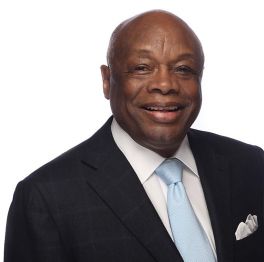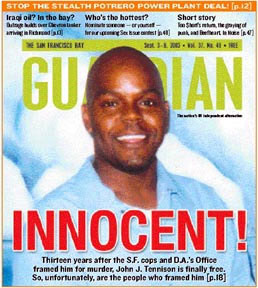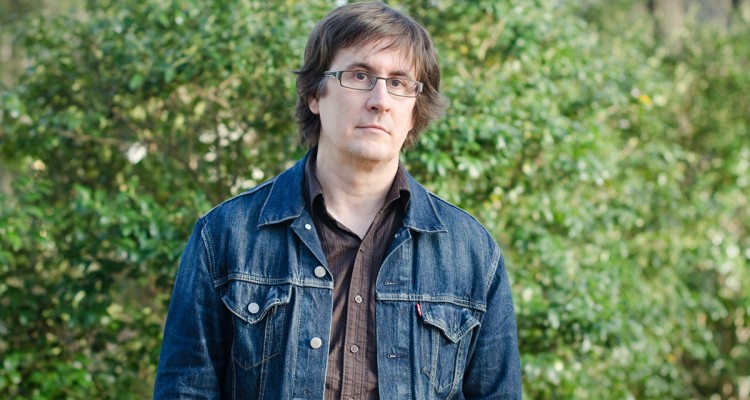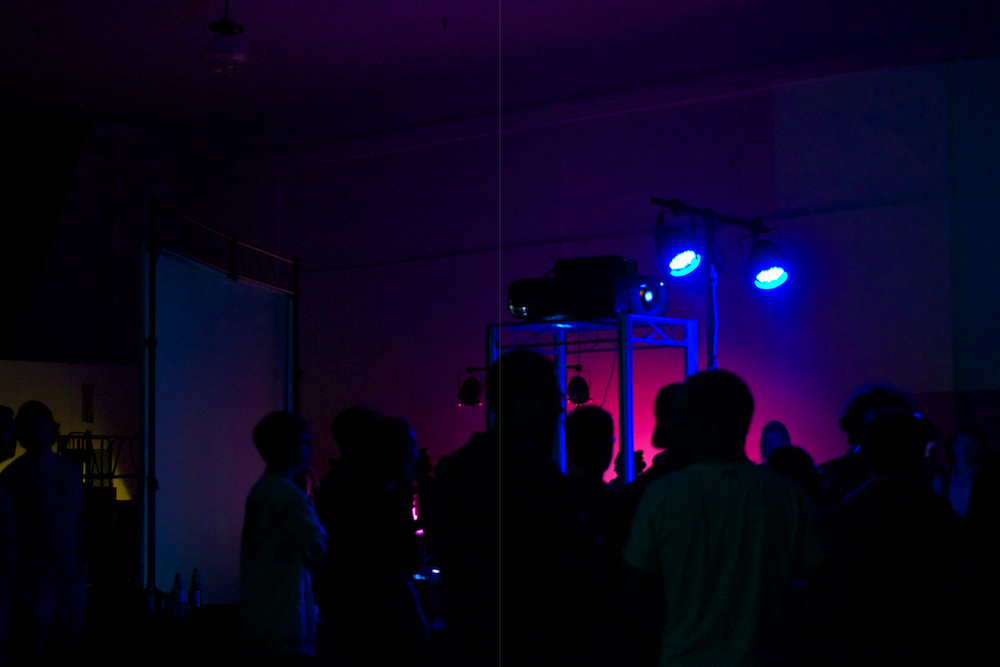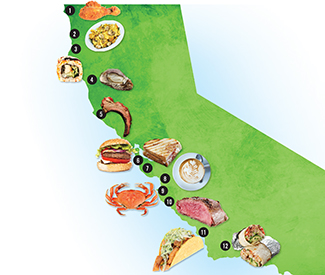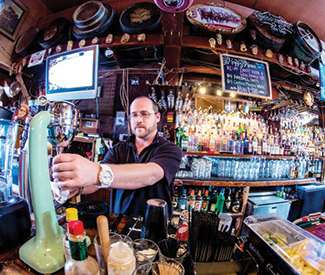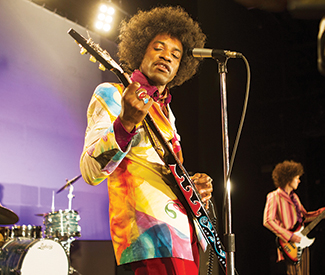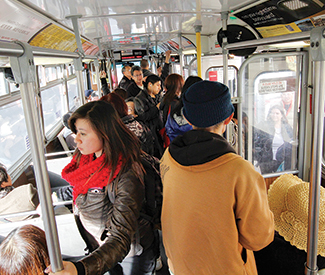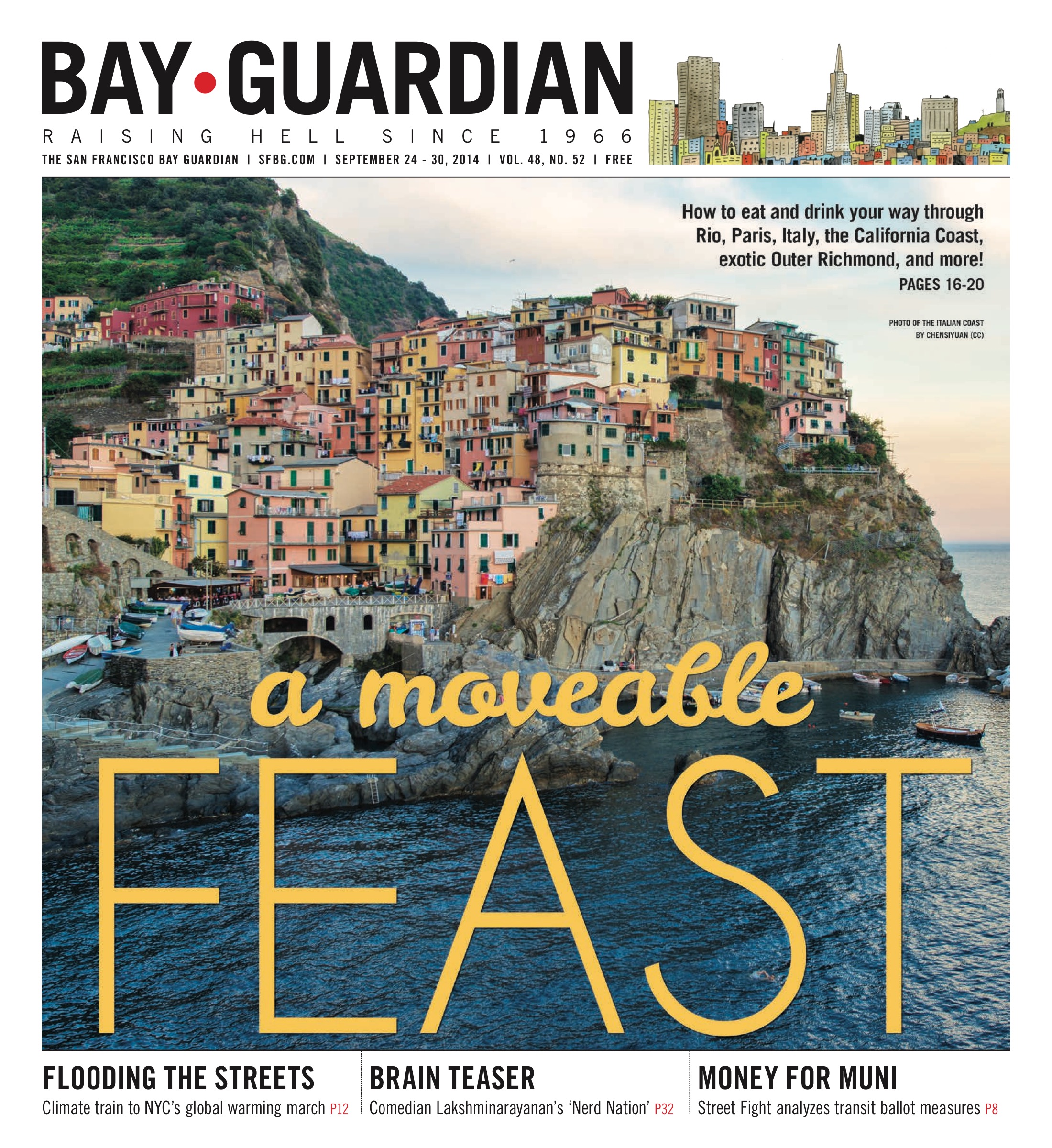Stage listings are compiled by Guardian staff. Performance times may change; call venues to confirm. Reviewers are Robert Avila, Rita Felciano, and Nicole Gluckstern. Submit items for the listings at listings@sfbg.com.
THEATER
OPENING
Ransom, Texas Tides Theatre, 533 Sutter, SF; www.tidestheatre.org. $10-30. Previews Sat/27, 8pm and Mon/29, 7pm. Opens Oct 2, 8pm. Runs Thu-Sat, 8pm. Through Oct 18. Virago Theatre Company performs William Bivins’ Texas-set tale of escalating tension between a father and son.
BAY AREA
Fire Work Live Oak Theatre, Live Oak Park, 1301 Shattuck, Berk; www.theatrefirst.com. $10-30. Previews Thu/25, 8pm. Opens Fri/26, 8pm. Runs Fri-Sat, 8pm; Sun, 5pm. Through Oct 19. TheatreFirst presents the world premiere of Lauren Gunderson’s romantic comedy.
ONGOING
The Barbary Coast Revue Sub/Mission Gallery, 2183 Mission, SF; www.barbarycoastrevue.com. $28. Sat, 8pm. Through Nov 29. Join Mark Twain on an interactive musical tour of Gold Rush-era San Francisco.
Cock New Conservatory Theatre Center, 25 Van Ness, SF; www.nctcsf.org. $25-45. Wed-Sat, 8pm; Sun, 2pm. Through Oct 12. New Conservatory Theatre Center performs Michael Bartlett’s comedy about a man who meets the woman of his dreams — while on a break from dating his boyfriend.
Each and Every Thing Marsh San Francisco Main Stage, 1062 Valencia, SF; www.themarsh.org. $20-50. Thu-Fri, 8pm; Sat, 5pm; Sun, 2pm. Extended through Oct 4. The latest solo show from celebrated writer-performer Dan Hoyle (Tings Dey Happen, The Real Americans) winds a more random course than usual across the country and abroad but then that’s the idea — or at least Hoyle warns us, right after an opening encounter with a touchy young white supremacist, that the trip he’s taking us on is a subtle one. Displaying again his exceptional gifts as a writer and protean performer, Hoyle deftly embodies a set of real-life encounters as a means of exploring the primacy and predicament of face-to-face communication in the age of Facebook. With the help of director Charlie Varon (who co-developed the piece with Hoyle and Maureen Towey), this comes across in an entertaining and swift-flowing 75-minute act that includes a witty rap about “phone zombies” and a Dylan-esque screed at a digital detox center. But the purported subject of connection, or lack there of, in our gadget-bound and atomized society is neither very original nor very deeply explored — nor is it necessarily very provocative in a theater, before an audience already primed for the live encounter. Far more interesting and central here is Hoyle’s relationship with his old college buddy Pratim, an Indian American in post-9/11 America whose words are filled with laid-back wisdom and wry humor. Also intriguing is the passing glimpse of early family life in the Hoyle household with Dan’s celebrated artist father, and working-class socialist, Geoff Hoyle. These relationships, rather than the sketches of strangers (albeit very graceful ones), seem the worthier subjects to mine for truth and meaning. Indeed, there’s a line spoken by Pratim that could sum up the essence of Hoyle’s particular art: “It’s so much better,” he says, “when you find yourself in other people than when you just find yourself.” Hoyle’s real frontier could end up being much more personal terrain, much closer to home. (Avila)
Foodies! The Musical Shelton Theater, 533 Sutter, SF; www.foodiesthemusical.com. $32-34. Fri-Sat, 8pm. Open-ended. AWAT Productions presents Morris Bobrow’s musical comedy revue all about food.
The Haze ACT Costume Shop, 1117 Market, SF; http://bit.ly/thehazeplayACT. $20. Thu/25, 7pm; Fri/26-Sat/27, 8pm. Heather Marlowe performs her solo show, a sharp-witted, autobiographical play about recovering from rape — and the way rape cases are mishandled by the justice system.
Ideation San Francisco Playhouse, 450 Post, SF; www.sfplayhouse.org. $20-120. Previews Wed/24-Fri/26, 8pm. Opens Sat/27, 8pm. Runs Tue-Thu, 7pm; Fri-Sat, 8pm (also Sat, 3pm; no matinee Sat/27); Sun, 2pm. SF Playhouse performs the world premiere of Aaron Loeb’s darkly comic suspense thriller.
King Fool Various locations TBA to reservation holders; www.weplayers.org. $30-50. Sat/27-Sun/28, times TBA. We Players presents a new, intimate, site-specific work inspired by King Lear.
The Late Wedding Thick House, 1695 18th St, SF; www.crowdedfire.org. $15-35. Wed-Sat, 8pm (no show Wed/24). Through Oct 11. Crowded Fire Theater performs a world premiere commission by Christopher Chen, a “journey of the soul” inspired by the work of Italian fabulist novelist Italo Calvino.
Motown the Musical Orpheum Theatre, 1192 Market, SF; www.shnsf.com. $45-210. Wed/24-Sat/27, 8pm (also Wed/24 and Sat/27, 2pm); Sun/28, 2pm. Over 40 hits (“My Girl,” “Ain’t No Mountain High Enough”) pack this tale of Motown founder Berry Gordy’s career in the music biz.
Noises Off! Shelton Theater, 533 Sutter, SF; www.sheltontheater.org. $38. Thu-Sat, 8pm. Through Oct 25. Shelton Theater performs Michael Frayn’s outrageous backstage comedy.
Old Hats ACT’s Geary Theater, 415 Geary, SF; www.act-sf.org. $20-120. Wed-Sat, 8pm and Tue/30 (also Sat, 2pm); Sun, 2pm. Extended through Oct 12. American Conservatory Theater presents Tony winners Bill Irwin and David Shiner in the West Coast premiere of Signature Theatre’s story of “clowns getting older — and even crazier.”
Pippin Golden Gate Theatre, 1 Taylor, SF; www.shnsf.com. $45-210. Tue-Sat, 8pm (also Wed and Sat, 2pm); Sun, 2pm. Through Oct 19. This new production of Roger O. Hirson and Stephen Schartz’s 1972 musical won the 2013 Tony for Best Revival of a Musical.
Semi-Famous: Hollywood Hell Tales from the Middle New venue: Marsh San Francisco, 1062 Valencia, SF; www.themarsh.org. $20-100. Sat, 8:30pm; Sun, 7pm. Through Oct 19. Don Reed’s latest solo show shares tales from his career in entertainment.
Slaughterhouse Five Gough Street Playhouse, 1620 Gough, SF; www.custommade.org. $20-50. Thu-Sat, 8pm; Sun, 7pm (also Oct 5 and 12, 3pm). Through Oct 12. Custom Made Theatre Co. performs Eric Simonson’s adaptation of the classic Kurt Vonnegut’s semi-autobiographical novel.
Too Much Light Makes the Baby Go Blind Boxcar Theatre, 505 Natoma, SF; www.sfneofuturists.com. $11-16. Fri-Sat, 9pm. Ongoing. The Neo-Futurists perform Greg Allen’s spontaneous, ever-changing show that crams 30 plays into 60 minutes.
BAY AREA
An Audience with Meow Meow Berkeley Repertory Theatre, Roda Theatre, 2015 Addison, Berk; www.berkeleyrep.org. $29-89. Tue and Thu-Sat, 8pm (also Sat and Oct 16, 2pm); Wed and Sun, 7pm (also Sun, 2pm). Through Oct 19. This self-styled “musical play” by a winking “post-post-modern” diva (the vocally and comically talented Australian chanteuse Meow Meow) is in fact much thinner than either category suggests — more like a tired music hall variety act. Written by Meow Meow and adapted and directed by Kneehigh’s Emma Rice, the routines are premised on the imperiousness and insecurities of a soi-disant megastar whose band and stage crew gradually abandon her, leaving her alone with her adoring audience. While there are one or two musical moments worth perking up a little for — in particular a vocally potent version of “Ne Me Quitte Pas,” and a mood-shifting rendition of Hans Eisler and Bertolt Brecht’s “The German Miserere” that feels incongruous here, like part of another and better show — the going is otherwise tough, the narrative forced and clunky in the extreme. Rice’s staging not only lacks inspiration but comes with a dismal abundance of low-hanging call-out-the-audience participation laughs. Barry Humphries’ Dame Edna (presumably an inspiration here) could get away with this get-the-guests approach, being a weightier and far wittier character. But here it comes across as a desperate attempt to sell a poorly written sketch supporting some unevenly appealing musical numbers. (Avila)
“Breaking Chains Festival” Various venues, Oakl (one venue in SF); www.ubuntutheaterproject.com. $15-25. Through Sat/27. New company Ubuntu Theater Project presents this festival of six site-specific works. Authors include Marcus Gardley, Tim Price, Clifford Odets, George Brant, Bennet Fisher, and N’Jameh Camera.
House and Garden Pear Avenue Theatre, 1220 Pear, Mtn View; www.thepear.org. $10-35. Thu-Sat, 8pm (also Sat, 2pm); Sun, 2pm. Through Oct 5. Pear Avenue Theatre performs Alan Ayckbourn’s two interlocking but separate comedies, a unique theatrical experience in which the audience stays put and the actors travel between adjacent theaters, performing each play at the same time.
An Ideal Husband Forest Meadows Amphitheater, 890 Belle, Dominican University of California, San Rafael; www.marinshakespeare.org. $12-35. Runs in repertory through Sat/27; visit website for specific performance dates and times. Marin Shakespeare Company performs Oscar Wilde’s witty tale.
Life Could Be a Dream Center REPertory Company, Lesher Center for the Arts, 1601 Civic, Walnut Creek; www.centerrep.org. $37-66. Wed, 7:30pm; Thu-Sat, 8pm (also Sat/27, 2:30pm); Sun, 2:30pm. Through Oct 5. CenterREPertory Company performs Roger Bean’s doo-wop musical.
Lovebirds Marsh Berkeley, 2120 Allston, Berk; www.themarsh.org. $20-100. Fri, 8pm; Sat, 8:30pm. Through Oct 18. Marga Gomez brings her solo show to Berkeley after runs in SF and NYC.
A Midsummer Night’s Dream Bruns Amphitheater, 100 California Shakespreare Theater Wy, Orinda; www.calshakes.org. $45-82. Wed/24-Thu/25, 7:30pm; Fri/26-Sat/27, 8pm; Sun/28, 4pm. Cal Shakes performs Shana Cooper’s remix of the Bard’s classic fantasy.
The New Electric Ballroom Ashby Stage, 1901 Ashby, Berk; www.shotgunplayers.org. $20-30. Wed-Thu, 7pm; Fri-Sat, 8pm; Sun, 5pm (Oct 5, show at 2pm). Through Oct 5. Shotgun Players perform Enda Walsh’s poetic nightmare about three sisters who are obsessed with their memories.
Rapture, Blister, Burn Aurora Theatre, 2081 Addison, Berk; www.auroratheatre.org. $32-50. Wed/24-Sat/27, 8pm; Sun/28, 2 and 7pm. Aurora Theatre Company opens its 23rd season with Gina Gionfriddo’s drama about three generations of women “struggling with feminism’s foibles.”
Romeo and Juliet Forest Meadows Amphitheater, 890 Belle, Dominican University of California, San Rafael; www.marinshakespeare.org. $12-35. Runs in repertory through Sun/28; visit website for specific performance dates and times. Marin Shakespeare continues its 25th season with the Bard’s timeless tragedy.
Year of the Rooster La Val’s Subterranean, 1834 Euclid, Berk; http://impacttheatre.com. $10-25. Thu-Sat, 8pm; Sun, 7pm. Through Oct 12. Impact Theatre performs Eric Dufault’s comedy, told from the point of view of a rooster that enters cockfights.
PERFORMANCE/DANCE
“AfroSolo Arts Festival: Black Voices Performance Series: Our Stories, Our Lives” African American Art and Culture Complex, 762 Fulton, SF; www.afrosolo.org. Program A: Fri/26, 8pm; Sun/28, 3pm. Program B: Sat/27, 8pm; Sun/28, 7pm. $15-50. Performers include Stephanie Anne Johnson, Lance Burton, Tarika Lewis, and DJ Lamont.
BATS Improv Bayfront Theater, B350 Fort Mason, SF; www.improv.org. $20. This week: special guests 3 For All, Fri/26-Sat/27, 8pm; Sun/28, 2pm.
“Bay Area Cabaret’s Opening Night Gala” Venetian Room, Fairmont San Francisco, 950 Mason, SF; www.bayareacabaret.org. Sun/27, 8pm. $60-75. Celebrating songwriter-composer Stephen Schwartz (Wicked) with Ana Gasteyer, Liz Callaway, and Michael McCorry Rose.
Caroline Lugo and Carolé Acuña’s Ballet Flamenco Peña Pachamama, 1630 Powell, SF; www.carolinalugo.com. Sun/28, Oct 4, 11, 16, 26, 6:30pm. $15-19. Flamenco performance by the mother-daughter dance company, featuring live musicians.
Doc’s Lab 124 Columbus, SF; www.docslabsf.com. This week: Comedy with Greg Edwards, Stroy Moyd, and Cameron Vannini, Wed/24, 8pm, $10-12; “Learn From Me: Comedy Showcase,” Thu/25, 8pm, $8-10; “Magicians and Mind Readers Christian Cagigal and Paul Draper, Fri/26, 8pm, $15-20; comedy with Joe Bartnick, Sal Calanni, and Al Gonzales, Sat/27, 8pm, $15-18; “Doc’s Comedy Open Mic,” Tue/30, 7pm, free.
“Dream Queens Revue Eighth Anniversary Show” Aunt Charlie’s Lounge, 133 Turk, SF; www.dreamqueensrevue.com. Wed/24, 9:30pm. Free. Drag with Collette LeGrande, Ruby Slippers, Sophilya Leggz, Bobby Ashton, and more.
“Exotic Destinations: Around the World in 80 Minutes” Sir Francis Drake Hotel, Empire Ballroom, Second Flr, 450 Powell, SF; www.sflgfb.org. Sat/27, 4-6pm. $10-20. The San Francisco Lesbian/Gay Freedom Band performs.
Feinstein’s at the Nikko 222 Mason, SF; www.feinsteinssf.com. This week: Clairdee in “More Melody Makers,” Wed/24, 7pm, $15; Charles Busch with musical director Tom Judson, Thu/25-Fri/26, 8pm, $35-50; Michael Cavanaugh from Broadway’s Movin’ Out, Sat/27, 7pm, $35-50; Frenchie Davis, Sun/28, 7pm, $25-40.
“Gallus Gallus Domesticus” CounterPULSE, 1310 Mission, SF; www.counterpulse.org. Fri/26-Sat/27, 8pm; Sun/28, 7pm. $15-20. Rosemary Hannon performs “a dance about fear and knowing how human it is to be chicken.”
“Have We Come a Long Way, Baby?” Joe Goode Annex, 401 Alabama, SF; www.brownpapertickets.com. Fri/25-Sat/27, 8pm. $25-50. Hope Mohr Dance’s fifth annual Bridge Project presents two evenings of solo performances by Anna Halprin, Simone Forti, Hope Mohr, and Peiling Kao, followed by panel discussions.
Lenora Lee Dance Dance Mission, 3316 24th St, SF; www.lenoraleedance.com. Program A: Fri/26-Sat/27, 8pm; Sun/28, 3pm; Program B: Oct 3-4, 8pm; Oct 5, 3pm. $15-50. Lenora Lee Dance presents its seventh anniversary season, two weekends of multimedia performances that tap into dance, martial arts, video projection, text, and music to tell stories of Chinese migrants in the United States.
“Magic at the Rex” Hotel Rex, 562 Sutter, SF; www.magicattherex.com. Sat, 8pm. Ongoing. $25. Magic and mystery with Adam Sachs and mentalist Sebastian Boswell III.
“Out of Line Improv” Stage Werx, 446 Valencia, SF; outoflineimprov.brownpapertickets.com. Sat, 10:30pm. Ongoing. $12. A new, completely improvised show every week.
“People in Plazas” Various locations, SF; www.peopleinplazas.org. Through Oct 3. Free. Lunchtime concerts in various downtown locations showcasing jazz, world, funk, and other styles of music.
“San Francisco Comedy College” Purple Onion at Kells, 530 Jackson, SF; www.purpleonionatkells.com. Ongoing. $5-15. “Weekly New Talent Shows,” Wed-Thu, 7pm. “Purple Onion All-Stars,” Wed-Thu, 8:15pm. “The Later Show,” Wed-Thu, 10pm. “The Cellar Dwellers” Fri-Sat, 7:30pm. This week’s “Cellar Dwellers” headliner is Beaumont Bacon.
“Terminator Too: Judgment Play” and “Point Break LIVE!” DNA Lounge, 375 11th St, SF; www.dnalounge.com. Oct 3, Nov 7, and Dec 5, Terminator at 7:30pm; Break at 11pm. $20-50. The raucous, interactive staged recreations of two of 1991’s greatest action films return to the DNA Lounge.
tinypistol ODC Theater, 3153 17th St, SF; www.odctheater.org. Thu/25-Sat/27, 8pm. $18-25. Maurya Kerr’s dance company performs the world premiere of beast and the reprise of Wantful.
“Wonderboy” and “29 Effeminate Gestures” Z Space, 450 Florida, SF; www.zspace.org. Thu/25-Sat/27 and Oct 2-4, 8pm; Sun/28 and Oct 4, 3pm. $15-70. Joe Goode Performance Group and Z Space present two of Goode’s signature works, including collaboration with puppeteer Basil Twist Wonderboy, and Goode’s iconic 1987 solo Gestures (performed by company member Melecio Estrella).
“Yatra: Journey from India to Spain” Palace of Fine Arts, 3301 Lyon, SF; www.kathak.org. Sat/27, 8pm; Sun/28, 2pm. $28-58. Kathak master Pandit Chitresh Das combines forces with flamenco artist Antonio Hidalgo Paz for this innovative new work.
BAY AREA
“Androcles and the Lion” Masquers Playhouse, 105 Park Place, Point Richmond; www.masquers.org. Fri/26-Sat/27, 8pm; Sun/28, 2 and 7pm. $10. Masquers Playhouse performs George Bernard Shaw’s classic.
“FSM” Thrust Stage, Berkeley Repertory Theatre, 2025 Addison, Berk; http://stagebridge.org. Sat/27, 8pm; Sun/28, 2 and 7pm. $20. Stagebridge presents a play with music about the 1964 Free Speech movement at Berkeley.
Indonesian American Cross-Cultural Concert Art House Gallery and Cultural Center, 2905 Shattuck, Berk. Sat/27, 7:30-9:30pm. $10-20. Lisa Graciano hosts this concert featuring shadow puppet master Midiyanto, gamelan music, Javanese dance, and more.
Mark Morris Dance Group and Music Ensemble Zellerbach Hall, 101 Zellerbach, Berk; www.calperformances.org. Thu/25-Sat/27, 8pm (also Sat/27, 2pm); Sun/28, 3pm. $40-96. Five performances in two separate programs, including the West Coast premiere of Crosswalk (2013) and four Bay Area premieres.
“MarshJam Improv Comedy Show” Marsh Berkeley, 2120 Allston, Berk; www.themarsh.org. Fri, 8pm. Ongoing. $10. Improv comedy with local legends and drop-in guests.
“Nerd Nation” Pacific Pinball Museum, 1510 Webster, Alameda; www.pacificpinball.org. Fri/26, 8pm. $15. Comedian and storyteller Dhaya Lakshminarayanan performs her work-in-progress solo show.
“Wavy Gravy’s Hippy Icon, Flower Geezer, and Temple of Accumulated Error” Marsh Berkeley, 2120 Allston, Berk; www.themarsh.org. Sat/27 and Oct 4, 8pm; Sun/28 and Oct 5, 2pm. $15-50. The peace activist, entertainer, and Ben and Jerry’s flavor inspiration performs his autobiographical solo show.
“What Rhymes with America” Douglas Morrison Theatre, 22311 N. Third St, Hayward; www.dmtonline.org.
Mon/29, 8pm. $10. Douglas Morrison Theatre kicks off its 2014-2015 Bare Bones staged reading series with Melissa James Gibson’s “funny-sad” play about lost souls. *



